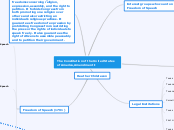realizată de Heather Christeson 8 ani în urmă
272
Policy Map - Spring 2017

realizată de Heather Christeson 8 ani în urmă
272

Mai multe ca acesta
"A kind of magnification that turns commonplace negative events into nightmarish monsters”, according to Burns.
Burns defines, "magnification as exaggerat[ing] the importance of things."
“Microagressions are small actions or word choices that seem on their face to have no malicious intent but that are thought of as a kind of violence nonetheless”, as defined by Lukianoff and Haidt.
"When speech comes to be seen as a form of violence, vindictive protectiveness can justify a hostile, and perhaps even violent, response”, as defined by Lukianoff and Haidt.
II. “Motivated reasoning”, “the idea that words (or smells or any sensory input) can trigger searing memories of past trauma - and intense fear that it may be repeated, also, a long list of ideas and attitudes that some students find politically offensive, in the name of preventing other students from being harmed, finally, to issue warnings before covering material that might evoke a negative emotional response”, as defined by Lukianoff and Haidt.
I. Alerts that something in a course might cause a strong emotional response; if a student has been previously victimized by racism, domestic violence, etc. they can choose to avoid these works, which they believe might “trigger” a recurrence of past trauma.”
Words that "by their very utterance inflict injury or tend to incite an immediate breach of peace." Fighting words are not subject to the restrictions of the First Amendment.
Untrue spoken statements that defame the character of a person.
False written statement that defames a person's character.
Any communication that belittles a person or group on the basis of characteristics.
Characteristics: A feature or quality belonging typically to a person, place, or thing and serving to identify it. Merriam-Webster
Identify: I. Establish or indicate who or what (someone or something) is. II. Associate (someone) closely with; regard (someone) as having strong links with. Merriam-Webster
Symbols, signs, and other methods of expression generally considered to be protected by the First Amendment.
Constitutional doctrine that prevents the government from prohibiting speech or publication before the fact; generally held to be in violation of the First Amendment.
https://www2.ed.gov/policy/gen/guid/religionandschools/prayer_guidance.html
https://firstliberty.org/?s=Prayer+in+school
http://www.nbcdfw.com/news/local/Texas-Attorney-General-Raises-Concerns-over-Frisco-School-Prayer-Room-416443563.html
https://texasleftist.com/
Arian Nation groups
http://www.rollingstone.com/politics/news/lone-star-crazy-how-right-wing-extremists-took-over-texas-20140701
NRA